A Timely Laloux Retrospective: Why Teal is Wrong! (And Why You Should Care)

Is there such thing as Spiral Dynamics?
Wholeness, self-management, evolutionary purpose – those are the key ingredients of an ideal "teal organisation". In his world-famous management bestseller, Laloux analyses a dozen companies, which he judged to have reached a worthy level of consciousness, and transcribes their most relevant practices. Indeed, so his hopeful doctrine suggests, the primordial force for the reinvention of our organisations is humankind’s continual awakening – relentlessly spiralling upwards, throughout the centuries, on a colourful staircase of spiritual stages. The colour system, first introduced by Beck and Cowan in their classical “Spiral Dynamics”, and further expanded by integral philosopher Ken Wilber, has fascinated consultants and faithful followers ever since. Conveniently, the big jump into a new “teal era” was postulated in 2014. Alas, the prophecy rests on shaky ground…
Revolution Disrupted: Deconstructing Teal
As fascinating and desirable a “teal” future appears to many of us, still fettered in the shackles of bureaucracy, Laloux’s conjectures are fraught with challenges:
- The “spiral of consciousness” is (mostly) wishful thinking: Laloux, like Wilbers, assumes that human consciousness inevitably shifts “upwards” throughout history; and that organisations will necessarily transform to healthier ways of management every time spirituality reaches the next “colour”.
Sadly, evidence for this rather flamboyant model of psycho-social evolution is scarce. Plus, the allegedly imminent overthrow of bureaucracies by a teal revolution has been slow to take hold. In fact, whilst there have been numerous attempts to render organisations more flexible - under fancy headings like “new work”, agile, humanocracy - a grassroot teal-ization of large companies is nowhere to be found.
Seven years after Laloux’s predictions went to print, most corporate rebels continue to fight lonely battles as “teal dots in an orange world”, and more purposeful work remains a lofty ideal for most…
- Wholeness is not enough (to reinvent organisations): Whilst Laloux demystifies much of Wilber’s integral psychology, vestiges of ideology remain.
For example, there is a strong notion of integratedness of teal – it somehow encompasses all previous colours. Thus, “living” teal organisations mysteriously contain and transcend the power hunger of a red organisation, the clarity of rules of an amber one, the eagerness to compete of an orange one and the community orientation of a green one. It is alleged that teal thus corresponds to the “self-actualisation” level in Maslow’s hierarchy of needs - which, however, as we have learned decades ago was never meant to be a hierarchy. Needs are not simply hierarchical and most probably neither are stages.
At the same time, it is also suggested, sotto voce, that later colours are not “better” than earlier ones - only ‘more complex’. Whilst maybe helpful to restrain feelings of superiority amongst teal disciples, tealorology thus appears to rather carelessly mixes personal development theory, moral philosophy and feel-good esotericism.
Truth is, we are continuously exposed to many colours (and infinite shades) in our daily lives. Whilst meditation and yoga classes may indeed help us to self-manage, they seldom teach us to how to make collective choices. We ultimately need a robust ethical framework to make “good” contextual decisions. Bringing our “whole selves to work” remains an imprecise logic to follow when arguing over budgets: just try telling your CEO that his "investment proposals are not teal enough"…
- Teal ain’t real and (sadly) ignores management science: Frederic Laloux carefully chooses and analyses twelve different companies in order to develop his acclaimed teal practices.
As Laloux freely admits and as even people with limited familiarity of academic research will instantly realise: evidence for a novel organisational model could never be deducted from such a small and strikingly diverse sample. Whilst many of the identified management practices are innovative and interesting in their own right, there is no way to prove effectiveness, coherence or correlation with a “teal” mindset. In fact, most of the referenced organisations would hardly identify with the book’s spiritual theme.
Most unfortunately, like other management consultants, Laloux focuses on spectacular case studies and ignores a cornucopia of pre-existent research on management practices and their impact on organisational health. Thus, a critical opportunity has been lost to craft a more consistent and compelling case for organisational transformation. Contrary to the book’s inspirational subtitle, teal eventually remains largely this: a thought-provoking “guide to creating new organisations” inspired by Laloux’s own level of consciousness.
- A dominant (orange) paradigm supplants all others: In my personal experience, business transformations do not simply fail because practitioners are immature, uncapable or unwilling, but also because much deeper cultural assumptions and beliefs go unexamined.
Different to the teal narrative, which often focuses on developmental psychology - as if large organisations were simply immature children who need to grow up – I will suggest that wider change is as much about an organisation’s cognitive capacity as about its context. In spite of colourful choices, most businesses remain stuck in the invisible force field and power structures of our most dominant worldviews. In order to progress towards more responsible and conscious organisations we must start at the system level and “rebalance society”, as Henry Mintzberg admonishes.
Indeed, post enlightenment, a pre-existent belief in universal morality and religion was thoroughly eradicated in industrialised Western societies. Progressively, scientific management filled gaps of meanings with a gospel of growth, and the pursuit of individualistic freedom and success became the uncontested aim of postmodern capitalism. Consequentially, management thinking today is focused on value extraction and competition, innovation and endless growth and, ultimately, profits and share prices.
Hence, reinventing our organisations and our economy will require not only consciousness and wholeness, but a wider societal rebalancing of profit vs purpose, individual vs collective; and a debate about the fact that we simply do not “own” the world – we are solely its trustees, for ourselves and generations to come. As Robert Putnam compellingly demonstrates, during the last two centuries we have gone full circle from an “I” society to a “We” society and back again. A change will require renewed commitment to mutual reciprocity across education, economy, government and civil society. We must re-learn to own the commons, without possessing them.
And, yes, it will come at a cost. But unless we truly embrace collective accountability for the future, countering the dominant selfish and short-sighted “orange” narrative with a more solidaric and humanistic vision of life, any revolution will ultimately fail.
Utopia for Corporate Realists: Teal 2.0
Whence to go from here? When presenting my thinking at the recent Teal Around the World conference my aim was certainly not to criticise teal – I am glad it exists - but to further develop its urgent theme, i.e., to reinvent our organisations for good. Laloux’s core premise is that consciousness and organisational development correlate. In other words, we must look both below and above the proverbial iceberg in order to transform our organisations. That is undoubtedly true. Without inner transformation, no change in structures, methodologies and tools will prove sustainable – whereas, by the same token, consciousness itself is insufficient. We cannot “think ourselves into a new way of acting, we must act ourselves into a new way of thinking”. However, teal has evident shortfalls on both sides and we must strengthen theory and practices to take it further.
Based on recent research, I will suggest that we can simplify Laloux’s framework and decode the arbitrary colour scheme to more closely reflect our everyday discussions. Thus, we move from a disputable “spiritual” theory towards a pragmatic mainstream conversation. Secondly, we can reconnect Laloux’s “levels of consciousness” with accepted and robust ethical frameworks and demonstrate how colours relate to fundamental choices about values. Finally, we can relate values to relational models and propose initial ideas about how to attain more coherence in organisational development – eventually, paving the way for teal 2.0
Step 1: From colours to relational models
For many years, renowned anthropologist Alan Fiske at the University of California in Los Angeles conducted extensive research across cultures and geographies to make a ground-breaking discovery: all human relationships can be reconducted to only four different relational models:
- Communal sharing: People treat each other as equals and undifferentiated in terms of their contribution to their community. Common norms are socially uphold.
- Authority ranking: People have asymmetrical positions in a linear hierarchy where subordinates defer, respect and obey while superiors take precedence and control
- Market Pricing: Relationships are oriented towards and discriminated by socially meaningful ratios or rates such as prices, wages, wealth or cost-benefit analyses
- Equality Matching: Relationships keep track of the balance or difference between the participants and know what is needed to restore the balance. Reciprocity rules.
Building on Fiske’s work, psychology professor Harry C. Triandis, at the University of Illinois, was able to prove that these relational models are closely linked to prevalent value systems. In particular, he demonstrated that certain models dominate whenever a society is either more collectivist and conservative or individualist and open to change, and when that society is more vertically oriented towards power and achievement or horizontally oriented with universalist beliefs based on a common good. Accepting that all of Laloux’s colours ultimately correspond to only four different relational models, we can try to simplify his system.
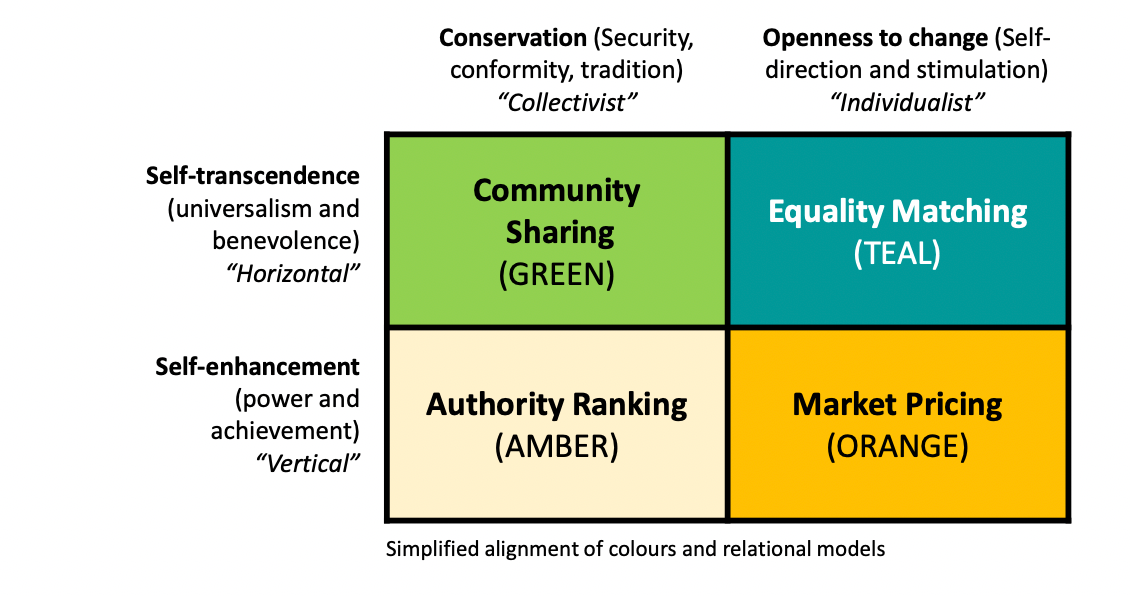
Step 2. From values to ethics
At this point, we can also replace the arbitrary colours with a set of more familiar narratives, connecting to the work of Peter Ulrich, Professor of Integrative Business Ethics at the University of St. Gallen. Indeed, the different colours, values and models reflect different socio-political belief systems: simplistically speaking, we can discern libertarian capitalism (orange), conservative (neo-liberal) capitalism (amber) and social capitalism (green).
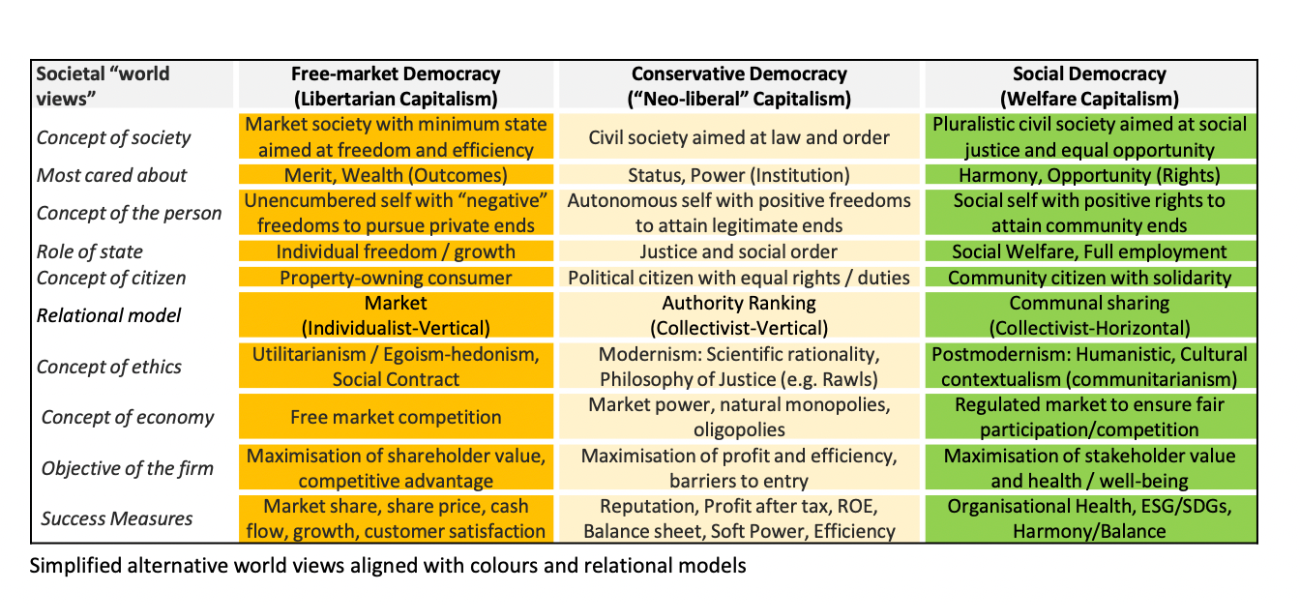
Rather than just evolving sequentially, these worldviews are omnipresent in our postmodern conversations. Importantly, however, they relate to discrete ideas about “what is good”. Green and Amber relate to so-called deontological ethics which postulates that an action is good if it follows the appropriate rules. Rules in the case of conservative democracy are laws and duties; in the case of social democracy what matters are responsibilities and human rights. Conversely, orange free-market democracy builds on so-called consequential (or utilitarian) ethics, i.e., an action is good if its consequences are net positive. In other words, if pleasure exceeds pain or benefits outweigh costs, for the majority, we should act. Sadly, in practice people often take shortcuts: rather than seeking to compute what is best for all, they simply do what is good for them.
Whilst we frequently compromise between alternative paradigms, they are logically and ethically largely incommensurable. At this point, it should become evident that rather than just representing levels of spirituality, different worldviews imply different ethical choices - about what we care for and how we treat each other, and about how we envisage the future of work.
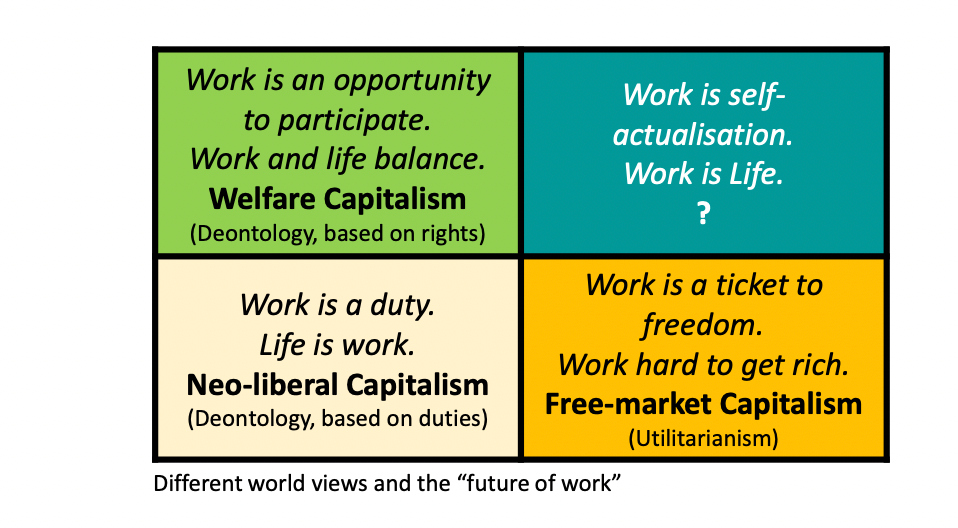
Step 3: From Consciousness to Virtues
As anticipated, teal is not based on a specific ethical theory, which makes it hard to expand and coherently “operationalise” as an alternative paradigm. However, not all hope is lost. Perhaps the third of the so-called general theories of ethics can come to our rescue. Similar to the integrative credo behind teal, Aristotle’s “virtue ethics” suggest that the purpose of humans is to attain a good life of flourishing and well-being (eudaimonia). “Good” people act habitually in virtuous ways to realise their unique human potential and enable a 'good life' for all. Our actions, as individuals and organisations, are not good because we follow the rule book or pursue positive profit (a desire for wealth as an end in itself is deemed unworthy) but because we act with agency and “moral character” - we become good by acting virtuously.
Combining our exploration of relational models and ethics, we can now sharpen Laloux’s metaphors for organisational development -
- In a MARKET organisation, all eyes are on customers and competition. Clients are allegedly king (in reality, profits rule). The culture is meritocratic, based on market success and growth and predominantly individualistic – driven by high-power incentives. The organisational focus is on innovation and creativity, driven by visionary entrepreneurship. Excitement is in the air, the "game is on" and sales is in charge.
- In a MACHINE organisation, order and rules are carved in stone. The CEO is the boss and the CFO is second in command. In traditionally bureaucratic organisations, long-term strategic and budgetary planning is highly ritualised. Positional authority is used by managers to impose control, driving continuous process improvements and predictability. Politics is prevalent, conformity is cultivated and the central head office sets the tone.
- A COMMUNITY organisation cares about its members and strives to do both well and good. Employees, customers and further stakeholders are at the top of an (inverted) hierarchy. The organisation values diversity and inclusion, trust and participation, as well as harmony between different categories of employees. Flat structures and empowered teams enable more informal collaboration. Managers act as coaches and "therapists". In practice, however, a “common” purpose and values are still defined by headquarters.
- In a LIVING ORGANISATION structures are heterogeneous, organic, self-managing and networked (yes, there might be hierarchies!). The setup is fluid, continually sensing and adapting to enable both individual and collective flourishing, in response to requirements, needs and circumstances. The culture is compassionate and curious, based on quality relationships and mutual commitment to enable aliveness at work. Leadership is shared and contextual, and employees act virtuously with self-determination and relational trust in teams. The organisation embraces deeply regenerative relationships inside and outside the business, to serve a “Good Society”. “Appropriate” profit is a signal of efficiency, not an objective.
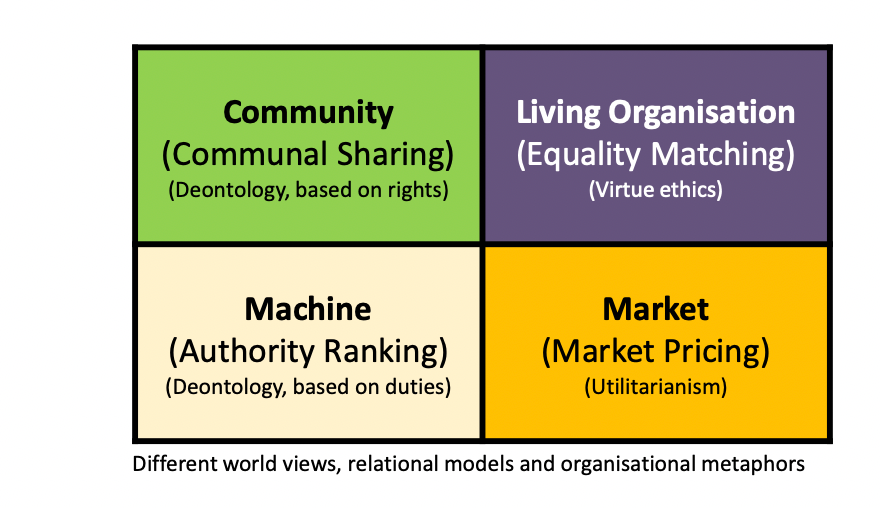
Step 4. A Coherent New Framework: Crafting Aliveness at Work
Having thus enhanced the organisational metaphors, how can we refine Laloux’s recommendations? We need a coherent set of practices, metrics and tools to transform traditional organisations. By defining human flourishing as the purpose of a living organisation, further insights arrive from the so-called “Positive Organisational Scholarship” movement. POS. researchers suggest three key drivers for “organisational aliveness”:
- Individual vitality: Employees’ needs for belonging, autonomy, self-esteem and mastery are met. They experience that their work is intrinsically motivating and that they can grow personally. They draw positive energy from their work.
- Organisational learning: Employees actively learn from and are happy to invest in each other. The energy of trusting and reciprocate quality relationships keep employees growing together. It is what leadership thinker Keith Ferrazzi calls co-elevation: We don't compete. We don't even collaborate. We elevate each other. Learning becomes the central glue of the social system.
- Systemic regeneration: Further aliveness is sparked by crafting regenerative and life-giving links with the wider ecology and nature. Surpassing an “anthropocentric” world view, the boundaries of the organisations are extended to attain deeper connection and meaning.
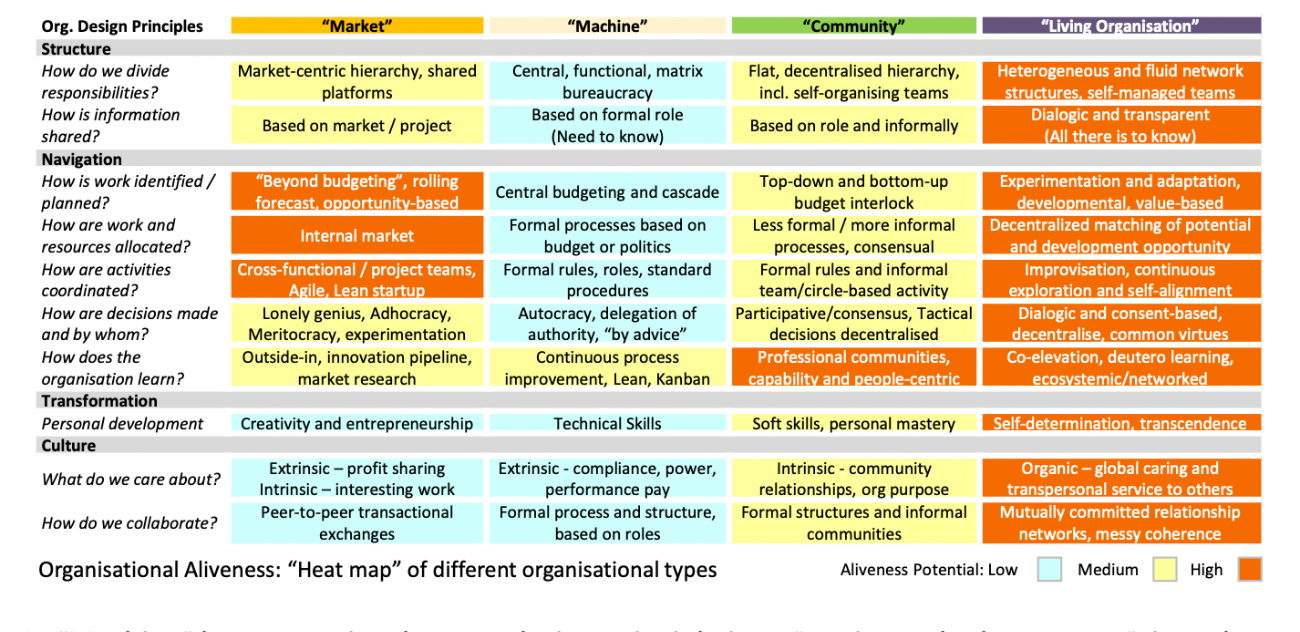
Assessing organisational aliveness, we can develop a “heat map” for every organisation. Whilst of course every business has its unique features and “energy profile”, important “aliveness gaps” are evident between different organisational types:
In “Machine” bureaucracies the core design principle is to “engineer the human out”, in order to make work predictable. Consequentially, its aliveness potential is low. “Family” and “Market” organisations have superior “energy profiles”: the former endorse community and organisational learning, whilst the latter foster individual creativity and exciting work opportunities. However, only a “Living Organisation” has the potential to fully unleash individual, social and ecosystemic aliveness by creating an environment where employees co-elevate and co-create a “good business”.
Un(b)locking the Revolution: Virtuous Leadership
In order to take our organisations on a journey towards aliveness, we must enable an environment where people collectively experiment and evolve, not only in terms of how they deliver, but also in regards to how they organise. Acknowledging organisations as complex developmental systems with minds and hearts and souls, rather than just an engineering challenge; where deep emotional bonds of community and trust matter as much as outcomes and where individuals and teams experience, learn and develop together - in service of a meaningful purpose.
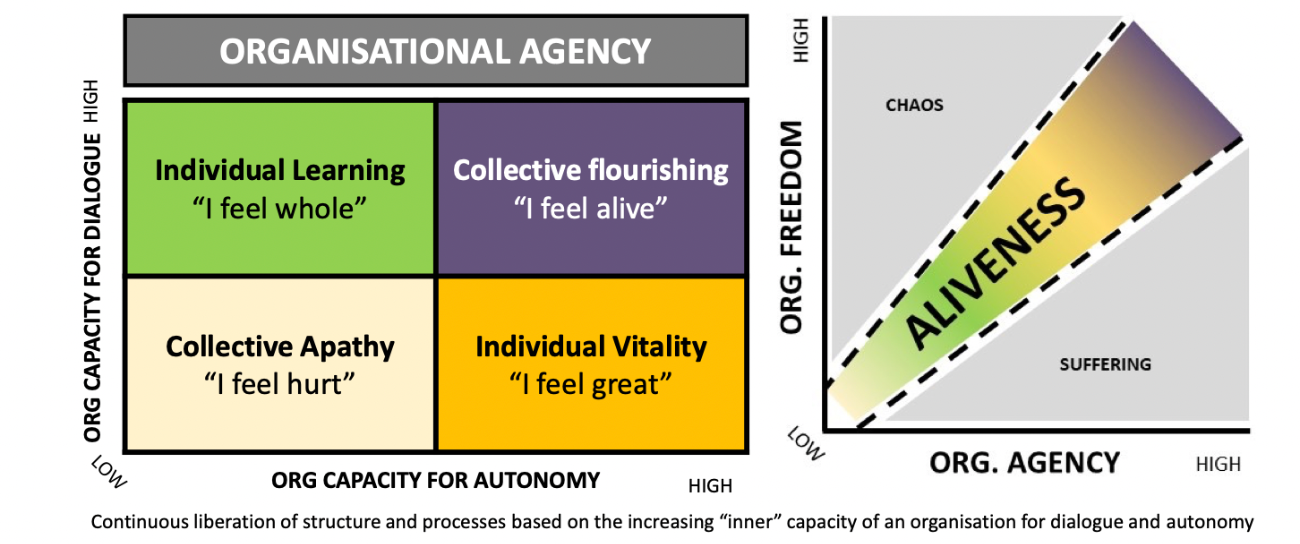
Such an evolution will require changes to structures, processes and culture as well as mature leadership. As Laloux suggests, the consciousness of an organisation can never surpass the consciousness of its leaders. Yet, I will again propose that spiritual growth is important but not sufficient - corporate leaders must embark on a voyage of “three different lives”:
- During the first life of a leader, they progressively understand, master and eventually embody the values and mindsets of their “institution. Identifying with their role, they progressively examine and manage their own thoughts, emotions and behaviours to become successful achievers within their business.
- During a second life and an often-turbulent transformation, they transcend a mainly “institutional” frame of mind. They embrace a greater sense and understanding of wholeness, complexity, interdependence and meaning, beyond their role. They become conscious of the system and able to navigate paradoxes as leader in role –in system, embracing mutually transformative relationships. Letting go of their own authority and redefining their role, they begin to focus on the systemic conditions to enable collective flourishing.
- Yet, only during their third life do leaders commit to courageously embody a “phronetic” moral stance. Deeply investigating organisational, personal and societal value systems, they eventually accept responsibility to “become the change they want to see in the world”. Combining practical wisdom and compassion, they begin to accept reciprocal interdependence and act as leader in role - in system – in context. They start to virtuously see and cultivate the development of the wider ecosystems in which they participate.
Eventually, becoming teal was never about reaching yet another colour, but about nurturing our collective ability to intentionally examine, develop and commit our organisations, and ourselves, to spark aliveness and serve a “good society”. To turn spirit into hope and faith and love and courage…
Together, we must be brave enough to believe again that our economy – first and foremost –serves humanity; that our work is not just barter for profit, but endowed with dignity and deep meaning within a flourishing ecology; that we must, individually and collectively, embrace mutual interdependence to address the complex challenges of our century; and that our organisations shall be beacons of life, cherishing our human spirit, rather than fearful suffering machines. Not just bigger, but better. Not just sustainable, but regenerative.
Contrary to prominent management bestsellers, excellence in business was never only about what we achieve, but always about why and how we act - about taking honourable care of people, society and planet. Teal might be erroneous, but its mission matters more than ever and progress remains inadequate. It’s time for all of us to unite behind its worthy intentions and show our true colours.
Further resources:
- Presentation TATW “Why Teal is Wrong” (Otti Vogt): https://www.youtube.com/watch?v=YSX-0bTS-48
- Letting Go Of Leadership (Otti Vogt): https://ottivogt.medium.com/letting-go-of-leadership-92d9e83d6b2a
- Bursting the Bubble: Teal Ain’t Real (Corporate Rebels): https://corporate-rebels.com/teal-aint-real/
- Frederic Laloux and His Critics (Frank Visser): http://www.integralworld.net/visser117.html


